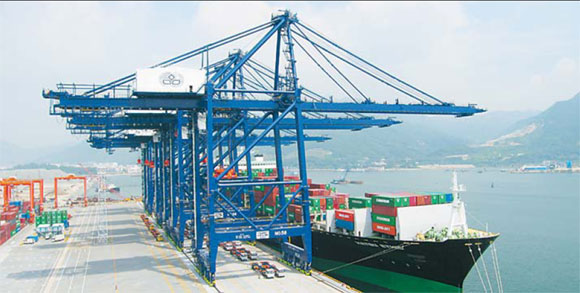Outlook for growth falls, yet remains double digit
|
Yantian Port in Shenzhen handled 10 million containers last year, the most of any terminal in China. Chen Wen |
After nearly 30 years of dramatic economic development, Shenzhen, China's first Special Economic Zone, has adjusted its growth forecast downward - but it remains at a two-digit level.
According to the annual government work report, the city's gross domestic product (GDP) is projected to increase 12 percent this year from 676.5 billion yuan in 2007, 2.7 percentage points lower than last year.
As the forerunner in the nation's reform and opening-up policy, Shenzhen has achieved stunning economic development that averaged annual GDP growth of about 28 percent from 1980 to 2002. It will celebrate the 28th anniversary of its establishment as a city in August.
Global and domestic economic factors along with resource and environmental concerns led the city government to moderate its projections on economic growth.
"There are also requirements to sustain stable and consistent economic growth and to balance the social and economic developments," said the government work report.
After identifying barriers to continued growth three years ago, including shortages of land, power and water, population growth and a worsening environment, the local government shifted its strategic focus from the speed of development to its quality.
It now uses a package of indices to measure the quality of economic growth.
In 2007, the GDP generated from every square km of land reached 346 million yuan, up 48 million yuan from a year before.
Power consumption for producing every 10,000 yuan of GDP, already half of the national average, continued to drop last year.
Water consumption per 10,000 yuan GDP decreased by 7 percent year-on-year to 27.7 cu m in 2007, half the world average. Emissions of sulfur dioxide and chemical oxygen demand fell 6.9 percent and 4.7 percent, respectively.
To further improve economic performance, the government plans to cut power and water consumption for every 10,000 yuan in GDP by 2.75 percent and 4 percent respectively this year.
"Given the levels are already low and a batch of important industrial projects will be put into operation this year, we set mild reduction targets for power consumption and water consumption," said Shenzhen Mayor Xu Zongheng.

"We will continue efforts to save energy and reduce emissions and actively develop a recycling economy to keep these indices at low levels," he added.
The government's painstaking efforts to upgrade its industrial structure also paid off. The service industry now accounts for 49 percent of the economy, following the manufacturing industry at 50.9 percent. Agriculture has narrowed to 0.1 percent.
Shenzhen's total industrial output value jumped 15.1 percent year-on-year to nearly 327 billion yuan in 2007 while total output value of the high-tech products increased by 20.5 percent to about 759.9 billion yuan.
The financial industry, one of the five major sectors in the city, also recorded faster development last year. Pre-tax profits of its financial institutions hit 75.9 billion yuan in 2007, double that of a year before.
Yet as an export-oriented city - exports totaled $168.2 billion last year, leading the country, as it has for 15 consecutive years - the government forecast that complex factors and uncertainties in global markets will have bigger impacts on Shenzhen than in other mainland cities this year.
Factors include the subprime mortgage crisis and US dollar depreciation, rising risks of global economic recession, falling global market demand, the rising price of oil, grain and raw materials, and spreading of global inflation.
"We might encounter a more severe international economic situation than the Asian financial crisis in 1997. Some negative impacts have already been seen in the global orders, operational costs of the corporations and trade disputes," said the government work report.
(China Daily 05/08/2008 page6)















